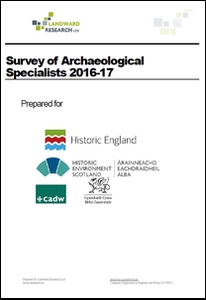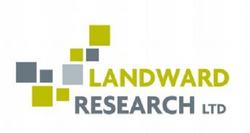Survey of Archaeological Specialists 2016-17
Kenneth Aitchison, 2017. https://doi.org/10.5284/1043769. How to cite using this DOI
Data copyright © Historic England unless otherwise stated
This work is licensed under the ADS Terms of Use and Access.
Primary contact
Dr
Kenneth
Aitchison
Executive Director
Landward Research Ltd
120 Bradley Street
Sheffield
S10 1PB
England
Resource identifiers
- ADS Collection: 2805
- DOI:https://doi.org/10.5284/1043769
- How to cite using this DOI
Introduction

A survey of archaeological specialists has found that, in early 2017, specialists appear to have recovered from the economic downturn of the previous decade, but are cautious about the possibility that there will be increased demand for their services in the near to medium future.
This study, which has aimed to collect data from a wide variety of areas of specialist activity within archaeology, received information from 882 specialists. The synthetic results presented here allow for comparison between specialisms and across broad specialist areas. A parallel survey, for buildings history and garden history, is presented in a separate report.
Comments received from respondents make it clear that not everyone who is working in this sector is doing this to earn a living, as some are delivering services on a voluntary basis.
The key findings of this survey are:
- Charges: Archaeological Specialists charge day rates between £40 - £3,000 with an average day rate of £259. Specialists’ charges have typically risen by more than inflation since the predecessor survey was undertaken in 2010-11.
- Charging levels: Typical charges are highest in the areas of survey and 'other' specialisms, and are lowest for illustration and archiving specialist services, as was the case in 2010-11.
- Competition: More archaeological specialists encounter 'very little' than encounter a 'great deal' of competition, as was the case in 2010-11.
- Employers: More archaeological specialists work for commercial companies (39.2%) than work for other forms of organisations; this is fundamentally unchanged from 2010-11, when the equivalent figure was 38.5%.
- Employer type: 63.2% of archaeological specialists work for larger organisations (with more than nine employees) in contrast with 2010-11, when more specialists were sole-traders than worked either small (up to nine employees) or large organisations.
- Location: Archaeological specialists are based throughout the UK, with the highest concentrations in Scotland, south-east and south-west England. In 2010-11 the highest concentrations were in southern England.
- Gender: 55% of archaeological specialists are female; in 2010-11, precisely 50% of the respondents to this survey who identified their gender were female and 50% were male.
- Age: The ages of archaeological specialists are relatively evenly distributed between 25 and 65, with the mean age of an archaeological specialist being calculated as 47.2. This effectively unchanged from 2010-11, when the average specialist’s age was calculated as 47.1.
- Ethnicity: Archaeological specialisms are ethnically unrepresentative of the UK workforce as a whole, with 97.5% being white. Ethnicity data were not collected in 2010-11.
- Disability: There is also a very low level (3.4%) of archaeological specialists with stated disabilities. Data on specialists’ disability status were not collected in 2010-11.
- Qualifications gained: More than three quarters (76.9%) of archaeological specialists hold a Masters degree or higher qualification. In 2010-11, 70% did.
- Retirement: 13.5% of archaeological specialists plan to retire in the next five years, with 28.6% planning on stopping working in the next 10 years. In 2010-11, 18.1% of specialists intended to retire within the next five years, and 39.8% within the next ten.
- Working hours: Just under two thirds of archaeological specialists work full-time. This represents a change from 2010-11, when only 44.3% did.
- Waiting lists: Less than half of archeological specialists currently have waiting lists of work indicating a potentially financially precarious level of demand. This is fundamentally unchanged from 2010-11.
- Qualifications needed: Most archaeological specialists believe a postgraduate Masters or PhD is required to become a specialist. Also, the majority believe new entrants need at least a year of experience and ongoing professional mentoring, as was the case in 2010-11. In 2010-11, the overwhelming majority (90%) of respondents thought new entrants needed at least an undergraduate degree, and slightly less than 50% thought a postgraduate qualification was required.
- Entry level training: Archaeological specialists consider that it is difficult for new entrants to gain initial specialist training, as was the case in 2010-11.
- CPD access: The majority of archaeological specialists consider that ongoing CPD training is “very” or “quite” difficult to access (as was the case in 2010-11); overall, CPD training is considered to be more difficult to access than entry-level training. This too is unchanged from 2010-11.
- CPD types: Reading professional publications, attending specialist and general conferences are the most preferred routes to obtain CPD. These were also the three most preferred routes to CPD in 2010-11.
- Skills loss: Only one area (Physical Dating) is considered to be at risk of skills loss as a result of a high proportion of current specialists intending to cease working within the next five years. In no areas were significant reductions in workload anticipated to lead to loss of expertise. By contrast, in 2010-11, every specialist area (where there were sufficient data available) could be considered to be either at acute or severe risk of skills losses.
- Future workload: Archaeological specialists anticipate that major infrastructure projects will lead to more projects, but with increased pressure on them to deliver; counterintuitively, the surveyed population believes this will both lead to them having to reduce their costs and to an overall reduction in the number of archaeological specialists.
- Brexit effect: It is anticipated that the UK’s forthcoming departure from the European Union will have relatively little effect on archaeological specialists’ working lives, but they do think it would also lead to a reduction in the number of archaeological specialists.
At the end of this report recommendations are made which set out possible actions for individual specialist practitioners, training providers and funding bodies to address some of the findings of this survey.








